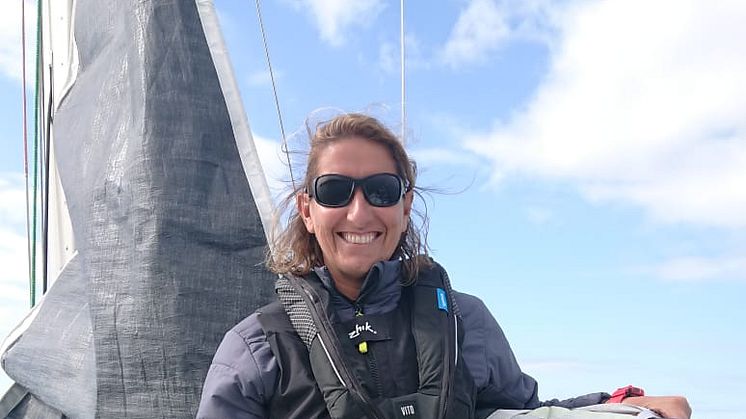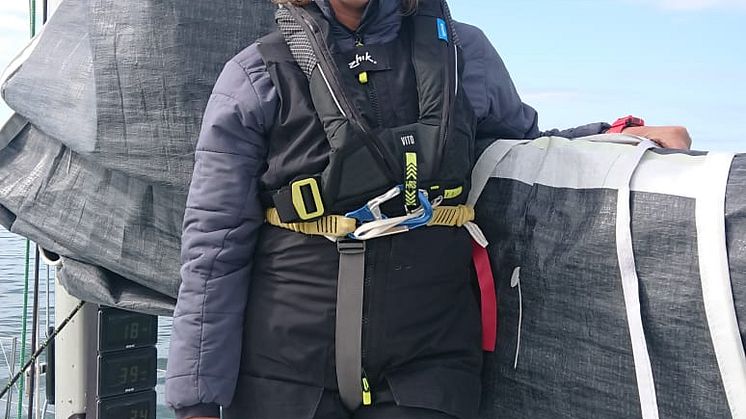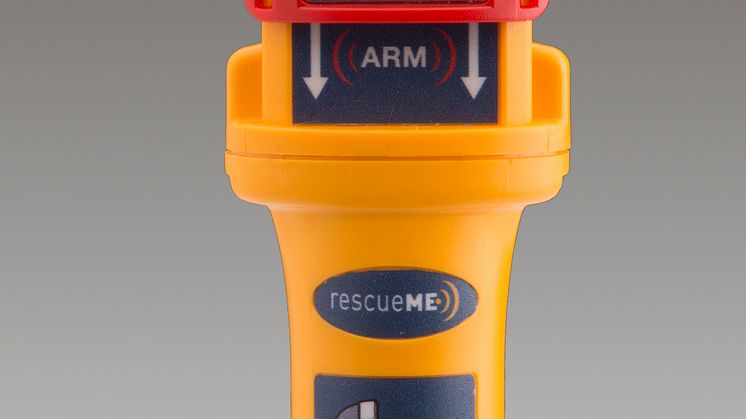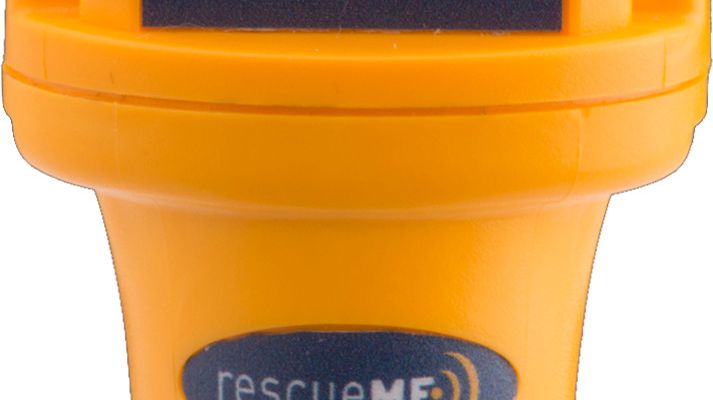
Press release -
Dee Caffari Reveals her Man Overboard Ordeal in Bid to Raise Safety at Sea Awareness for Fellow Sailors
As a committed advocate for safety at sea, record-breaking yachtswoman Dee Caffari MBE has revealed details of her own shocking first-hand experience of falling overboard during a recent offshore race, with the hope that her story will highlight the lessons learned for the benefit of other sailors.
Dee, who has sailed around the world six times and is the first woman to have sailed single-handed and non-stop around the world in both directions, was competing in this year’s SoCal 300 ocean race from Santa Barbara to San Diego starting on 30 May when the unimaginable happened and she found herself viewing the boat from the water.
One of nine crew on a Santa Cruz 50, Dee was trimming the spinnaker while sitting, feet in, on the high side of the cockpit on a dark night at around midnight, with winds gusting up to 30 knots, rough sea conditions and a boat speed of between 16 to 22 knots. She was wearing an Ocean Signal rescueME MOB1 man overboard device with integrated AIS and DSC attached to her Spinlock Vito Deckvest, but was not clipped on with her tether, despite the rule on the boat to always clip on at night.
Dee recounted in her blog: “We had a wave that knocked us into a big windward roll, I remember reaching out to the lifelines behind me to brace myself. As we came out of that windward roll, we started to heel the opposite way and the boat began to broach.
“I was easing the spinnaker as smoothly as possible to avoid an override and to help the helm gain control and ensure they could bear away again. As the boat continued to heel, I remember not having anywhere to place my foot to leeward to brace myself. It was then that I felt myself falling. I assumed I would land on the leeward side deck with my back against the lifelines. Instead I had cleared the lifelines and the next thing I knew I was viewing the boat and all the action from about 20 feet away in the water.
“I wanted to shout out to let them know where I was and that I was okay, but I was being pulled through the water by the spinnaker sheet that I was still holding onto. I decided to try and kick for the aft quarter of the yacht. At the same time, I was flailing my legs around to try and move in the water, the crew onboard were dropping the spinnaker and driving the boat head to wind to slow down. This action facilitated my movement towards the back of the boat. Here, I was able to grab the aft stanchion of the pushpit and I saw a familiar face of one of the crew.
“Once the spinnaker was secured down the forward hatch the crew came aft and recovered me from the water. I could sense the relief from those around me and this heightened my embarrassment. Once sat on the aft deck I could deflate my lifejacket to allow me more manoeuvrability and finally turn my AIS beacon off. This was strobing really brightly, obscuring my night vision and also causing a lot of noise on our DSC VHF that my unit had been programmed to. All exactly as you want it to.”
In a bid to raise awareness about the best safety equipment and procedures, Dee has admitted the fault is entirely her own for not clipping on with her tether. She stresses the capability and training required for crew to act quickly for a speedy recovery, as well as a thorough debrief after any emergency to make necessary improvements.
Dee has also emphasised the importance of wearing a man overboard device, such as the Ocean Signal rescueME MOB1, to quickly alert the boat’s crew and other vessels in the vicinity to the location of the casualty when every second counts, especially in cold water.
Dee, who sits on the Operations Committee for the RNLI, added: “I would definitely recommend the Ocean Signal rescueME MOB1. With an increased use of AIS monitoring it is an easy to use and easy to carry unit that has a big impact on the screens of both commercial and leisure markets. It is easy to fit for automatic deployment by the lifejacket inflation and even if you are after a unit to stand alone it can easily fit into a pocket without taking up too much room and restricting your mobility.
“I had selected this product because it is small and compact and fits into the lifejacket easily for automatic use. I also like the fact that it has AIS and DSC abilities.
“My recent experience in an offshore race was from the position of the man overboard. Something you hope you will never be, and I never imagined I would be. The end result is a happy one, I came back onboard but this does allow me to speak of the incident from my perspective which is very unusual. I believe it is important to share my experience so that it can help highlight areas for discussion and lessons that can be learnt.”
Last year, Dee completed the Volvo Ocean Race skippering Turn the Tide on Plastic - the second time she has led a crew around the world. In 2006, she became the first woman to sail solo round the world against the prevailing winds and currents and was awarded the MBE in recognition of this achievement. Visit Dee’s website at www.deecaffari.co.uk or see her Facebook page for more information. For Dee’s full account of the man overboard incident, see http://www.deecaffari.co.uk/2019/06/12/man-overboard/.
Ocean Signal provides a free replacement beacon for all owners of its rescueME and SafeSea devices who activate their PLB, MOB or EPIRB in an emergency.
For more information about the rescueME MOB1 and other Ocean Signal products,www.oceansignal.com.
Ends
Notes for editors:
About Ocean Signal rescueME MOB1
In the event of a person falling overboard, the rescueME MOB1 is automatically triggered the moment the life jacket is inflated, sending the first alert within 15 seconds. The device transmits an alert to all AIS receivers and AIS-enabled plotters in the vicinity, with the integrated 66-channel GPS ensuring accurate position data is sent back to the boat and any other assisting vessels for at least 24 hours. Secondly, the MOB1 will activate the DSC alarm on the vessel’s VHF radio to alert fellow crew members. The integrated strobe light with moulded lens ensures the survivor is easily spotted in poor light conditions.
The Ocean Signal rescueME MOB1 is the world’s smallest personal locating AIS man overboard device with integrated DSC. It is designed to fit seamlessly into even the smallest lifejacket.
For further information, please contact:
James Hewitt
Ocean Signal
Tel: +44 (0)1843 282930
E-mail: james.hewitt@oceansignal.com
www.oceansignal.com
or
Jules Riegal
Saltwater Stone
Tel: +44(0)1202 669244
E-mail: j.riegal@saltwater-stone.com
www.saltwater-stone.com
Related links
Topics
Categories
About Ocean Signal
Communication and safety at sea specialist Ocean Signal™ is dedicated to providing the technology and quality of product that will set industry standards.
Ocean Signal’s product portfolio consists of the rescueME range of products, including the rescueME PLB1, the rescueME MOB1, the rescueME EPIRB1 and the rescueME EDF1 electronic distress flare, plus the AIS Alarm Box, and the SafeSea range of GMDSS products, including the E100 and E100G EPIRB, S100 SART and V100 handheld VHF radio, as well as the M100 and M100X professional MSLD and E101V float-free EPIRB with integrated voyage data record memory capsule. They provide both recreational and commercial mariners with simple to use, compact and affordable life-saving solutions. All products are engineered by a highly experienced team of marine electronics professionals.
Ocean Signal products are trusted by high-profile sailors, rowers, surfers and powerboat racing teams. Providing some of the world’s best competitors and adventurers with vital safety and communication devices, the rescueME MOB1 and rescuePLB1 were integrated with the Spinlock lifejacket and personal equipment packs for the crews in the Volvo Ocean Race 2017-18 and the rescueME MOB1 was also selected to enhance safety standards for crew taking part in the Clipper 2017-18 Round the World Yacht Race. Ocean Signal has also sponsored the crew of Simply Fun with rescueME MOB1s, rescueME PLBs and a rescueME EPIRB1 in the 2016 Rolex Sydney Hobart Yacht Race, the 16-man crew of Triton with rescueME MOB1s in the 2015 Rolex Sydney Hobart Yacht Race,record-breaking sailor Andrea Mura in the single-handed OSTAR race, Mini Transat 2015 solo sailor Lizzy Foreman, ocean rowing teams including Ocean Valour, Ocean Brothers and Carbon Zerow and solo rower Lia Ditton, Venture Cup offshore powerboat race team Cinzano, kite racer Gina Hewson and canoeist Adam Weymouth.
Safety and communication products from Ocean Signal offer exceptional value, meeting or exceeding international technical and safety standards. Careful design and innovation provide commercial shipping, fishing and recreational users the confidence that their Ocean Signal equipment will work to, and beyond, their expectations when it is needed most.



